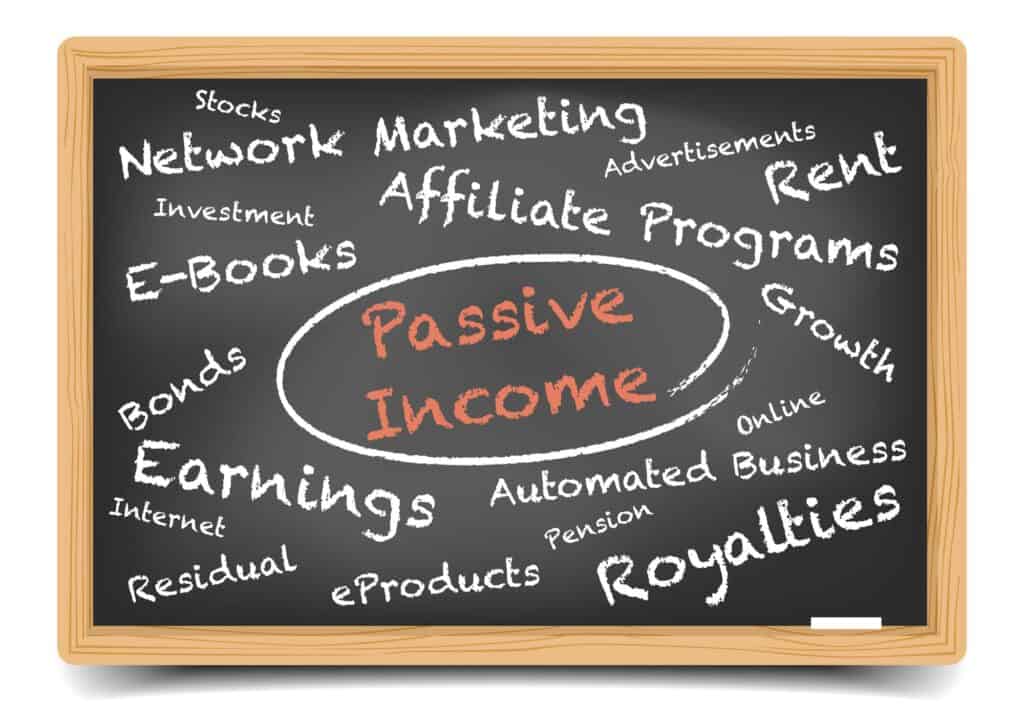Curious about earning income on autopilot? Passive income solutions can turn that curiosity into reality. This guide lays out a series of strategic avenues, from effortless investments to digital innovation, to help you build up streams of income that require little to no maintenance. Start charting a course towards financial independence through the diverse options we’ve mapped out for you.
Disclaimer: This information is general in nature and for informational purposes only. It is not personal financial advice and has not taken into account your personal financial position or objectives. Make sure to refer to a licensed financial or tax advisor.
Table of Contents
Key Takeaways
- Passive income is essential for financial independence and can be derived from various sources including rental properties, stocks, digital products, and more, requiring minimal effort post-setup.
- Diversifying income with passive streams is crucial in today’s unpredictable economy, acting as a safety net against downturns and allowing greater financial flexibility and resilience.
- Creating a passive income strategy should be well-planned, considering individual risk tolerance and goals, with options ranging from real estate investments to digital ventures like online courses and affiliate marketing.
The Essence of Passive Income
What defines passive income? Essentially, it’s an income source that requires minimal effort to maintain after its initial setup. It’s cash flow that trickles in from:
- rental properties
- dividends
- business royalties
- investments
- affiliate marketing
- online courses or digital products
Picture a stream that keeps flowing regardless of whether you’re actively fetching water from it. That’s a passive income stream. It’s different from active income, like a job or salary, which requires a direct exchange of time for money.
Earning passive income paves the path to financial liberation and adaptability, akin to possessing a self-sustaining golden goose. Beyond providing extra money to pay bills or splurge on luxuries, it creates opportunities to pursue passions, take risks, and build wealth over time. And the best part? There are countless passive income ideas to create passive income streams, tailored to your talents, interests, and risk tolerance, including generating passive income.
The Significance of Passive Income in Today’s Economy
Given the dynamic and unpredictable nature of the modern world, diversifying income streams is not just a wise decision, it’s a necessity for survival. Passive income can be your lifeboat in rough economic seas. It’s like having an umbrella on a rainy day, providing an extra layer of security.
Diversifying your income streams, including various forms of passive income, is a prudent strategy to shield against financial risk. Think of it as spreading your eggs across multiple baskets. If one basket falls, you still have the others intact. With passive income, you’re not tied to a single job or source of income, making you more resilient to economic downturns and market shifts.
Crafting a Passive Income Strategy
Forming a passive income stream isn’t merely about choosing a method and plunging in. It demands strategic planning, akin to organizing a successful journey. You need to consider your starting point, desired destination, and the best route to get there. Similarly, your passive income strategy should reflect your financial goals, risk tolerance, and chosen investment paths.
Risk tolerance is a crucial factor in your journey. It’s a measure of the investment loss you’re willing to endure. Knowing your risk tolerance can guide your passive income investment choices. For example, if you’re a thrill-seeker willing to take on higher risks for potentially bigger rewards, you might choose stocks or equity funds. If you prefer a smoother ride, bonds or income funds might be more your speed. Your risk tolerance is influenced by factors such as:
- age
- income
- financial goals
- time until retirement
Understanding it allows you to create a passive income strategy that aligns with your comfort level and financial aspirations.
Real Estate Revenue Streams

Real estate, a proven channel for wealth accumulation and passive income generation, can be compared to owning a fertile land that cultivates money trees. Let’s delve into the bounties that real estate investments can offer, from rental properties to real estate investment trusts (REITs).
Rental Property Riches
Envision owning a property that remunerates you monthly. Indeed, we’re referring to rental properties— a lucrative avenue for passive income. It’s like having a money tree in your backyard that bears fruit every month. But like any tree, it needs proper care and management to keep it healthy and productive.
Hiring a property management company can be a game-changer. They are the gardeners who nurture your money tree. They handle tenant disputes, maintenance issues, and payments, freeing up your time and reducing stress. Plus, these experts are well-versed in local regulations and housing laws. It’s crucial to choose a reliable company that aligns with your goals and matches your property type. With the right team, you can maximize your rental income and keep your money tree thriving.
Trusting in REITs
If managing rental properties seems daunting, don’t fret. There’s another way to reap the rewards of real estate without the hassles of being a landlord: REITs. Think of them as mutual funds for real estate. They own, operate, or finance income-producing properties, giving you a slice of the real estate pie without the need to buy or manage properties yourself.
REITs can offer significant benefits, including:
- High dividend yields
- Potential capital appreciation
- Easy to buy, just like stocks
- Provide a more hands-off approach to real estate investing
They’re like golden eggs that can grow your wealth over time.
Whether you’re a seasoned investor or a newbie, REITs offer a viable route to diversify your portfolio and generate passive income.
Dividends: A Stock Market Approach
The stock market is another fertile ground for passive income, particularly dividend-paying stocks. These are companies that share a portion of their profits with shareholders. It’s like owning a piece of a money-making machine that pays you a portion of its earnings.
Let’s delve deeper into the world of dividend stocks and exchange-traded funds (ETFs).
Stock Market Mastery
Investing in dividend-paying stocks can be both rewarding and challenging. It’s like navigating a treasure hunt—you need a map (strategy), patience, and a keen eye. The treasure? Regular income through dividend payments and potential capital appreciation of the stock price.
Successful navigation requires careful selection and assessment. Key metrics to consider include:
- Dividend yield
- Payout ratios
- Total return
- Earnings per share
- Price-to-earnings ratio
Additionally, consider the company’s track record of dividend growth and its financial health.
With a thoughtful strategy, you can unlock the treasure chest of dividends and enjoy the spoils of your upfront investment.
ETFs for Ease and Diversity
Exchange-traded funds (ETFs) are another gem in the treasure chest of the stock market. They’re like a magic carpet that carries a diversified portfolio in a single investment. ETFs spread the risk across multiple stocks, and they’re easy to buy and sell, just like individual stocks.
ETFs offer the following benefits:
- Cost savings with lower expense ratios compared to actively managed funds
- Tax efficiency, often incurring fewer capital gains
- Attractive yields and cost-effective investment opportunities
Incorporating ETFs into your investment portfolio can help reduce volatility and enhance total returns, making your financial journey smoother and potentially more rewarding.
High Yield Savings and Money Markets
If you’re looking for a less adventurous, more stable path to passive income, high-yield savings accounts and money market accounts might be your ticket. They’re like safe harbors in the stormy sea of riskier investments, offering a low-risk option for passive income.
Maximizing Interest with High Yield Savings
High-yield savings accounts offer:
- Better-than-average interest rates on your deposits
- Risk-free opportunity to grow your savings, as they’re typically insured by FDIC
- Flexibility to access your funds whenever you need without penalty.
Choosing a high-yield savings account isn’t just about the interest rate. Consider the financial institution’s reputation, fees, customer service, and the compounding frequency of interest.
A well-chosen high-yield savings account can act as a powerful tool to grow your wealth steadily and securely.
Money Markets as a Middle Ground
Money market accounts are another safe harbor for your funds. They offer easier access to your money compared to high-yield savings accounts, with features like check writing and debit card access. However, the comfort of easier access comes with a price—money market accounts typically require higher minimum balances.
Choosing between a high-yield savings account and a money market account depends on your needs. Here are some factors to consider:
- If you want higher access to your funds, a money market account might suit you.
- If you can afford to lock your funds for a longer period, a high-yield savings account might be a better option.
- In either case, you can enjoy a steady stream of passive income with minimal risk.
Digital Domain: Online Courses and E-Books

The digital world offers a vast ocean of passive income opportunities. With a little creativity and expertise, you can create and sell digital products like online courses and e-books. It’s like having a virtual shop where customers come to learn and gain value from your knowledge.
Crafting an Online Course
An online course can be viewed as a trove of knowledge marketed to enthusiastic learners. It’s a packaged expertise that meets the surging demand for online education. To create a successful course, consider your area of expertise, target audience, and a well-structured curriculum.
Marketing your course requires identifying its unique value, conducting audience research, and using keyword-rich titles for better online discovery. Choosing the right platform for hosting your course is also crucial. With a well-crafted online course, you can share your knowledge and earn passive income simultaneously.
E-Book Earnings
E-books, another gem in the repertoire of digital products, are akin to virtual books authored by you and marketed to an expectant audience. With compelling content and a solid marketing strategy, you can stand out in the bustling e-book market and generate a steady stream of passive income.
Writing and publishing e-books require creativity, a knack for writing, and a deep understanding of your target audience. It’s more than just penning down thoughts—it’s about delivering value to your readers. With the right strategy, you can turn your ideas into income, one e-book at a time.
Peer-to-Peer Lending and Microloans

Peer-to-peer lending functions as a digital marketplace facilitating loans between individuals. It’s like being a digital bank, offering high potential returns and diversification. In this marketplace, you can lend money and earn interest, making it a valuable addition to your passive income strategy.
But like any marketplace, peer-to-peer lending comes with its own risks. It’s not insured or protected by the government, which means you bear the risk of borrower defaults. However, with diligent research and a balanced approach, you can navigate these risks and reap the rewards of this burgeoning marketplace.
Affiliate Marketing Ventures
In affiliate marketing, you act as a digital salesperson, endorsing third-party products and earning commissions from subsequent purchases. It’s a win-win—you earn passive income, and the company gets more customers.
However, successful affiliate marketing requires more than just sharing a product link. It involves selecting relevant products, creating quality promotional content, and using effective marketing strategies. With a strategic approach and persistent effort, affiliate marketing can become a lucrative source of passive income.
Building a YouTube Channel
YouTube provides a worldwide platform to showcase your creativity and generate passive income, functioning as a digital stage for compensated performances. Creating a successful YouTube channel requires consistent content creation, smart marketing, and a deep understanding of your audience.
However, building a successful YouTube channel is not a walk in the park—it requires patience, persistence, and a lot of hard work. But don’t let that deter you. With the right strategy and consistent effort, you can turn your YouTube channel into a lucrative source of passive income.
Tapping Into the Gig Economy
The gig economy unfolds myriad passive income opportunities. Whether it is leasing your property on Airbnb or lending your car on Turo, you can monetize your assets. It’s like turning your unused resources into money-making machines.
However, like any income-generating venture, these opportunities come with their own risks and challenges. It requires effective management and strategic planning to optimize your earnings. But with the right approach, you can tap into the gig economy, generate income, earn money, and create a steady stream of passive income.
From Ideas to Income: Selling Your Creativity
For the creatively inclined, ideas can be transformed into income. Be it stock photography, design, or writing, your creative works can be monetized. It’s like having a virtual art gallery where customers come to appreciate and buy your creations.
Selling your creativity requires more than just talent. It requires a platform to showcase your work, a strategy to attract customers, and a mechanism to process payments. But with the right strategy and persistent effort, you can turn your creativity into a sustainable source of passive income.
Nurturing a Blog for Bucks
Blogging presents another route to passive income, akin to maintaining a digital journal where your thoughts, experiences, and insights can be shared globally for remuneration. Successful blogging requires consistent posting of high-quality content, effective marketing, and a deep understanding of your audience.
Like any venture, blogging comes with its own set of challenges. It takes time to build an audience and generate consistent income. But with patience, persistence, and a passion for your topic, you can nurture your blog into a money-making machine.
The Bond Ladder Blueprint
Establishing a bond ladder can be equated to constructing a staircase leading to passive income. It involves buying bonds that mature at different times, reducing reinvestment risk and providing a steady income. It’s a strategic approach to bond investing that offers both stability and flexibility.
Building a bond ladder requires careful planning and selection of bonds. It involves balancing the yield and maturity of each bond to align with your financial goals and risk tolerance. With the right blueprint, a bond ladder can be a valuable tool in your passive income portfolio.
The Power of Passive Business Investments
Passive business investments involve holding a stake in a profitable venture, sans the daily management hassles. As a silent partner, you invest in a business and earn a portion of the profits. It’s a powerful way to generate passive income and build wealth.
However, like any investment, passive business investments come with their own set of risks. It’s crucial to conduct thorough due diligence, understand the business model, and assess the potential returns before investing. With a strategic approach, passive business investments can significantly enhance your income.
Crypto Earnings: Staking and DeFi
The realm of cryptocurrencies presents a novel landscape for passive income, with several avenues like staking and decentralized finance (DeFi) for earning income via digital currencies. It’s like venturing into a digital gold mine, where you can unearth valuable digital assets.
However, like any investment, crypto earnings come with their own set of risks. The volatile nature of cryptocurrencies, regulatory uncertainties, and technological complexities make it a challenging terrain to navigate. But with a sound understanding of the crypto landscape, you can tap into its potential and generate a steady stream of passive income.
Summary
In conclusion, generating passive income is like embarking on a journey towards financial freedom. From real estate investments to crypto earnings, there are numerous pathways to explore. Each path comes with its own set of challenges and rewards. But with a well-crafted strategy, patience, and consistent effort, you can unlock the door to financial independence and live the life you’ve always dreamed of.
Frequently Asked Questions
How can I make $1000 a month passively?
You can make $1000 a month passively by exploring passive income ideas such as starting a YouTube channel, creating a membership website, or investing in real estate. Give these ideas a try and see which one works best for you!
How to make $5,000 a month in dividends?
To make $5,000 a month in dividends, you would need to have a portfolio value of approximately $1 million invested in stocks with an average dividend yield of 5%. For example, with a 2.7% annual yield from Johnson & Johnson stock, $1 million invested would generate about $2,250 per month.
What is passive income and how is it different from active income?
Passive income is money earned with little effort after the initial setup, while active income requires trading time for money, such as a job or salary.
How can I generate passive income through real estate?
You can generate passive income through real estate by investing in rental properties and real estate investment trusts (REITs). Rental properties involve buying properties and renting them out, while REITs allow you to invest in income-producing real estate without owning properties yourself.
What is a bond ladder and how can it generate passive income?
A bond ladder is a series of bonds that mature at different times, providing a steady income and reducing reinvestment risk. This strategic approach to bond investing offers both stability and flexibility.







